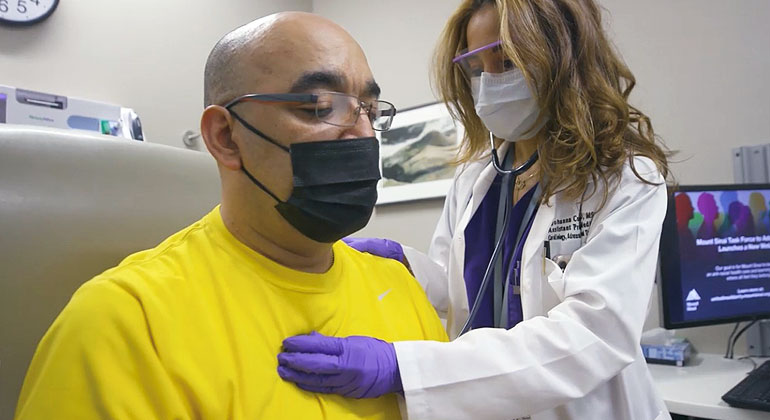
One Hispanic Man’s Journey to Acceptance for a Heart Transplant
The situation was simple: José Rodriguez needed a new heart. Yet when offered the opportunity for a transplant, José’s answer was a resounding “no.”
The reasons for his refusal were complex, but the bottom line for José was that he would rather die than undergo the procedure. “That’s not for me,” he at first told heart failure specialist Johanna Contreras, MD, Associate Professor of Medicine (Cardiology) at the Icahn School of Medicine at Mount Sinai. She explained that the chance to be matched with a heart donor is a precious opportunity. There are rigorous criteria to qualify, including blood type, tissue matching, and overall suitability. But José was adamant.
This is all too familiar a response, especially among Hispanic patients, says Dr. Contreras, who has studied heart health disparities. Many in the Hispanic community have a distrust of the transplant process, Dr. Contreras says, and they believe that it is still an experimental process.
“I sometimes tell a patient, ‘You are not going to survive with the heart you have, and once it starts to fail, it causes complications in the other organs.’ And they say no. They don’t want anything,” Dr. Contreras said. She led a study of national data from 2007 to 2016 and found that the number of heart transplants increased for both non-Hispanic whites and Hispanics. But there was a much smaller increase in both donors and transplant recipients among Hispanics.
Dr. Contreras feels that it is vitally important to correct such disparities in the Hispanic community, who are at a higher risk for heart disease and heart failure. First, heart transplants have become much more commonplace—and the results are extremely favorable. Although heart transplants carry risks, 85 percent of heart transplant patients live past the first year, which is the most critical. The median survival rate is 14 years. And while “many associate the heart with the soul and feelings, it is an organ like any other,” Dr. Contreras says.
José’s journey from no to yes was a complicated one. Earlier, in his 40s, he began to have difficulty breathing and experienced swelling in his limbs. He tried to dismiss the symptoms as the result of minor causes, but his condition worsened.
José finally had to go to the hospital, and he was told that his heart had become too large and he needed a transplant. “From the beginning when they told me about the transplant, I said no, that’s not for me. I would rather die than submit to one,” he said in a report about his health journey on Univision.
José struggled on for a few more years, but he wound up in the hospital again, practically unable to breathe or walk. “I was suffocating,” José says, “and everything was swollen.” This time, Dr. Contreras was his physician. And his situation was now an emergency. “There was no time to wait for a transplant,” Dr. Contreras says. “He was not going to survive.”
Dr. Contreras recommended implanting a device to help his heart pump blood more strongly, called a left ventricular assist device (LVAD). But again José resisted. “I refused until the last moment until the doctor told me, ‘José, if you don’t wear this, you’re going to die.’ She had to really scare me,” he says.
He got the LVAD, and he agreed to be put on the list for a heart transplant. His quality of life improved immediately, and for the first time in years he was reminded what it was like to live without feeling like he was suffocating. Mechanical pumps such as the LVAD enable patients to recover much of their lost vitality. And for patients who aren’t eligible for heart transplants, they can add decades of life. The device also enables patients like José to wait for a suitable donor, which may take a long time.
But for José, it came surprisingly soon. He remembers receiving the call from Dr. Contreras with a mixture of astonishment and terror—so much so that she had to call him twice before it set in that this was real. “I was alone in my house, and they told me they had found a heart for me. It was a shock. I started to cry. But 24 hours later, I had a new heart.”
Two weeks after the transplant, José was back home. And two months later, he was back at work. Today, he feels like a new man and is even able to go fishing. “If I had known that everything was going to turn out so well, I would have opted for the operation much earlier,” he says.
And he is aware of his good fortune. “Not everyone is lucky enough to receive a heart. I am grateful to my hero, my donor. He gave me the gift of life. I want to write his family a letter, and let them know that their son lives in me and that I will take care of his heart.”